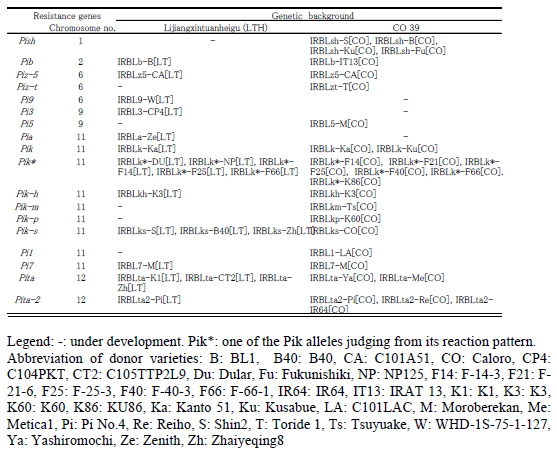Near isogenic lines of rice for blast resistance genes as differential varieties
Description
Rice blast caused by a highly variable pathogen, Magnaporthe oryzae B. Couch, is one of the most important diseases that reduce rice productivity worldwide. The use of resistant varieties is the most practical and economical approach to control this disease. As a useful tool to develop resistant varieties, the IRRI–Japan Collaborative Research Project released monogenic lines (MLs) for blast resistance with the genetic background of a Japonica-type rice variety, Lijiangxintuanheigu (LTH) as the first set of international standard differential varieties (DVs). However, many of the MLs showed significant differences from LTH for several agronomic traits. This may be due to the introgression of large chromosomal segments from the donor varieties, because the MLs were derived after only one to three backcrosses. Here, we developed near isogenic lines (NILs) containing single blast resistance genes by performing six backcrosses of the donors to LTH and an Indica-type variety, CO 39.
Twenty NILs containing 11 blast resistance genes derived from 19 donor varieties and 27 NILs containing 14 genes from 26 varieties were developed with the genetic backgrounds of LTH and CO 39, respectively (Table 1). The NILs showed similar reaction patterns to those of the corresponding resistance-containing monogenic lines (MLs) when challenged with 20 standard blast isolates from the Philippines, suggesting that the target resistance genes were successfully introduced. The introgression of the targeted resistance genes was further confirmed by SSR markers that were located within the chromosome regions where the resistance genes had previously been mapped. Genome surveys using SSR markers showed that the NILs had genetic compositions more similar to that of the recurrent parents than did the MLs. The morphological characteristics of each NIL were generally similar to those of the respective recurrent parents (Fig.1).
These NILs are expected to be valuable genetic tools for research and breeding programs for blast resistance. Seeds of these lines can be obtained from JIRCAS and IRRI.
Figure, table
-
Table 1. Target genes and donor parents of blast differential varieties with the genetic background of LTH and CO 39
-
Fig.1. Donor variety of resistance gene (Upper), Near-isogenic line, IRBL9-W[LT] (Middle), and recurrent parent LTH (Lower).
- Affiliation
-
Japan International Research Center for Agricultural Sciences Biological Resources Division
- Classification
-
Administration A
- Term of research
-
FY1994~2010
- Responsible researcher
-
KOBAYASHI Nobuya ( Biological Resources Division )
TELEBANCO-YANORIA Mary Jeanie Telebenco ( International Rice Research Institute )
FUKUTA Yoshimichi ( Biological Resources Division )
KOIDE Yohei ( Biological Resources Division )
Kato Hiroshi ( Institute of Crop Science, NARO )
Imbe Tokio ( Kyushu Okinawa Agricultural Research Center, NARO )
- ほか
- Publication, etc.
-
https://doi.org/10.1270/jsbbs.60.629
Telebanco-Yanoria, Mary Jeanie, et al. "Development of near-isogenic lines of Japonica-type rice variety Lijiangxintuanheigu as differentials for blast resistance." Breeding science 60.5 (2010): 629-638.
https://doi.org/ 10.1007/s11032-010-9437-xTelebanco-Yanoria, Mary Jeanie, et al. "A set of near-isogenic lines of Indica-type rice variety CO 39 as differential varieties for blast resistance." Molecular breeding 27.3 (2011): 357-373.
- Japanese PDF
-
2010_seikajouhou_A4_ja_Part10.pdf352.17 KB


![図1 育成したLTHの準同質遺伝子系統、IRBL9-W[LT] 図1 育成したLTHの準同質遺伝子系統、IRBL9-W[LT]](/sites/default/files/202010/2010-10b.gif)